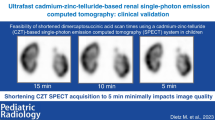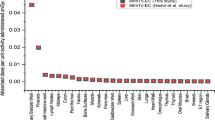Abstract
Purpose
In 2013, the Japanese Society of Nuclear Medicine (JSNM) announced consensus guidelines for pediatric nuclear medicine. These JSNM guidelines proposed use of lower administered doses compared with traditionally determined doses, which were estimated from age, weight or body surface area (BSA) based on the administered dose for adults in Japan. When the JSNM guidelines are used, the relationship between this recommended administered dose and image quality remains unclear. In this study, we clarified the relationship between administered dose and image quality for pediatric 99mTc-DMSA renal scan retrospectively, and verified the diagnosable image quality with the recommended administered dose of the JSNM guidelines.
Materials and methods
Data from 7 pediatric patients who underwent 99mTc-DMSA dynamic renal scans according to the guidelines’ recommended doses were collected. Scan frame rate was 1 frame/min, and scan time was up to 8 min. Eight images, which had different acquired time periods from 1 min to 8 min were prepared by adding each frame. Nine nuclear medicine specialists determined 8 images with different acquired times as diagnosable or undiagnosable. A region of interest (ROI) with 50% thresholds was placed on each kidney of every image. Coefficient of variation (CV) was calculated by dividing the standard deviation (σ) by the mean counts (µ) of each ROI (CV = σ/µ × 100). 99mTc-DMSA renal scans (total of 2821 cases) that were performed previously in collaboration with 6 hospitals were collected, and CVs of these images were calculated in all cases. These 2821 cases were separated into 5 groups for every 10 kg weight; i.e., (1) less than 10 kg, (2) 10–19.9 kg, (3) 20–29.9 kg, (4) 30–39.9 kg, and (5) above 40 kg. Regression line of each group was analyzed in relation to the CV and administered dose. The CV at the point of intersection with the recommended dose range from the guideline was determined for each group. This CV value was considered as the estimated CV of the image obtained when the recommended dose of the guideline was used. Thus, if the CV was equal to or less than the estimated CV value, then the diagnostic image quality was deemed satisfactory.
Results
Average CV of the lower limit of diagnosable images in 7 cases as determined by 9 nuclear medicine specialists was 19.9%. Estimated CV was 21.2–24.2% in the group weighing < 10 kg (group 1), 19.9–20.6% in the group weighing > 10 kg and < 20 kg (group 2), 19.6% in group weighing > 20 kg and < 30 kg (group 3), 19.4–19.5% in the group weighing > 30 kg and < 40 kg (group 4), and 19.8% in the group weighing > 40 kg (group 5). The estimated CVs from groups 1 and 2 with weight < 20 kg exceeded 19.9%.
Conclusions
Although 99mTc-DMSA renal scan can be carried out using the guidelines’ recommended dose with conventional image acquisition time in patients weighing 20 kg or more, those < 20 kg need consideration for a longer image acquisition time to obtain diagnosable images.







Similar content being viewed by others
References
Koizumi K, Masaki H, Matsuda H, Uchiyama M, Okuno M. JSNM Optimization Committee for Pediatric Nuclear Medicine Studies. Japanese consensus guidelines for pediatric nuclear medicine. Ann Nucl Med. 2014;28:498–503.
Lassmann M, Biassoni L, Monsieurs M, Franzius C, Jacobs F. EANM Dosimetry and Paediatrics Committees. The new EANM paediatric dosage card. Eur J Nucl Med Mol Imaging. 2007;34:796–8.
Gelfand MJ, Parisi MT, Treves ST. Pediatric radiopharmaceutical administered doses: 2010 North American consensus guidelines. J Nucl Med. 2011;52:318–22.
Subcommittee for Standardization of Radionuclide Imaging, Medical and Pharmaceutical Committee, Japan Radioisotope Association. Recommendation for pediatric dose in nuclear imaging (in Japanese). Radioisotopes. 1988;37:627–32.
Everitt B, Skrondal A. The Cambridge dictionary of statistics. New York: Cambridge University Press; 2010.
Piepsz A, Colarinha P, Gordon I, Hahn K, Olivier P, Roca I, Sixt R, Velzen JV. Guidelines on 99MTc-DMSA Scintigraphy in Children. Revised Guidelines on 99MTc-DMSA Scintigraphy in Children. 2009 (Original version published in Eur J Nucl Med. 2001;28(3):37–41).
Fahey FH, Ziniel SI, Manion D, Treves ST. Effects of Image Gently and the North American guidelines: administered activities in children at 13 North American pediatric hospitals. J Nucl Med. 2015;56(6):962–7.
Fahey FH, Ziniel SI, Manion D, Baker A, Treves ST. Administered activities for pediatric nuclear medicine procedures and the impact of the 2010 North American Guidelines on general hospitals in the United States. J Nucl Med. 2016;57(9):1478–85.
Author information
Authors and Affiliations
Corresponding author
Rights and permissions
About this article
Cite this article
Fujiwara, T., Hidaka, K., Sugibayashi, K. et al. Investigation of the relation between administered dose and image quality for pediatric 99mTc-DMSA renal scintigraphy: clinical study applying the JSNM (Japanese Society of Nuclear Medicine) pediatric dosage card. Ann Nucl Med 33, 153–159 (2019). https://doi.org/10.1007/s12149-018-1320-6
Received:
Accepted:
Published:
Issue Date:
DOI: https://doi.org/10.1007/s12149-018-1320-6




